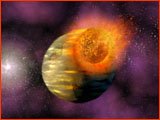 |
 |
 |
Part 2 | Back to Part 1 The Big Whack Rather than clarifying the issue of the moon's origin, the Apollo data only complicated it. As Hartmann declared in Origin of the Moon, a 1984 book he co-edited with two other researchers, "neither the Apollo astronauts, the Luna vehicles, nor all the king's horses and all the king's men could assemble enough data to explain the circumstances of the moon's birth." Many felt something else was needed. It came in the mid-1970s, when a new theory of lunar origin began to emerge. It rose phoenix-like from the ashes of constraints not adequately met in tests of the three other models. First, Hartmann, along with Planetary Science Institute colleague Don Davis, determined that a roving planetoid, large enough to blast off enough mantle material to make the moon, could have struck the Earth shortly after its formation. (Previous work had held that the solar system had long since run out of planet-sized meteors.) Working independently, Alastair Cameron and William Ward of Harvard University concluded that an impact from a body at least as large as Mars could have supplied the rough material for the moon and also given our bipartite system its angular momentum. The "Big Whack" theory was born. The giant-impact hypothesis, as it's more formally known, initially had little impact of its own. If Nature abhors a vacuum, researchers generally abhor catastrophic solutions to geophysical problems, Hartmann says; such solutions are too tidy. So the theory languished for a decade. As Robin Canup, an astrophysicist at the Southwest Research Institute in Boulder, Colorado, put it, "At first it was seen as ad hoc, probably unlikely, possibly ridiculous." But in 1984, a seminal conference devoted to the moon's origin that was held in Kona, Hawaii jumpstarted research.
In contrast to the Big Three, the Big Whack stands up nicely against what we now know of the moon. According to theoretical models, the impact would have destroyed the impactor, sending most of its remains, along with huge amounts of the Earth's mantle, into an Earth-orbiting debris cloud that ultimately coalesced into the moon. This would explain the reduced density of the moon, which is believed to be composed of two-thirds impactor and one-third Earth mantle. And it explains its tiny core: Since the models suggest that all of the impactor's core wound up in the Earth's core, the moon must have got its core iron from later, smaller impacts. By the same token, Earth got its additional volatile elements from later impacts from comets and carbonaceous meteors. Finally, the Big Whack can account well for the Earth-moon's angular momentum and even our planet's odd, 23.5-degree tilt off the ecliptic plane (the invisible platter on which nearly all planets orbit the sun).
"If we can get to a point where we can naturally explain with our theoretical models the chemical signatures and elemental abundances in the lunar material," Canup says, "to me that's the nail in the coffins of the other theories." Cameron concurs. "Quite independently of the giant-impact theory," he says, "they were sealed long ago." Peter Tyson is Online Producer of NOVA. Photos: NASA Explore the Moon | Lunar Puzzlers | Last Man on the Moon Hear the Space Pioneers | Origins | Resources Transcript | Site Map | To the Moon Home Editor's Picks | Previous Sites | Join Us/E-mail | TV/Web Schedule About NOVA | Teachers | Site Map | Shop | Jobs | Search | To print PBS Online | NOVA Online | WGBH © | Updated November 2000 |
 View an animation of the hypothesized Big Whack,
in which a planet-sized meteor slams into Earth, creating a debris cloud that later coalesces into the moon.
View an animation of the hypothesized Big Whack,
in which a planet-sized meteor slams into Earth, creating a debris cloud that later coalesces into the moon. Some scientists believe a meteor two to
three times the size of Mars slammed into Earth, providing the raw material for
the moon.
Some scientists believe a meteor two to
three times the size of Mars slammed into Earth, providing the raw material for
the moon.
 While the Big Whack currently leads theories of the moon's
origins, our satellite will always remain tantalizingly enigmatic.
While the Big Whack currently leads theories of the moon's
origins, our satellite will always remain tantalizingly enigmatic.